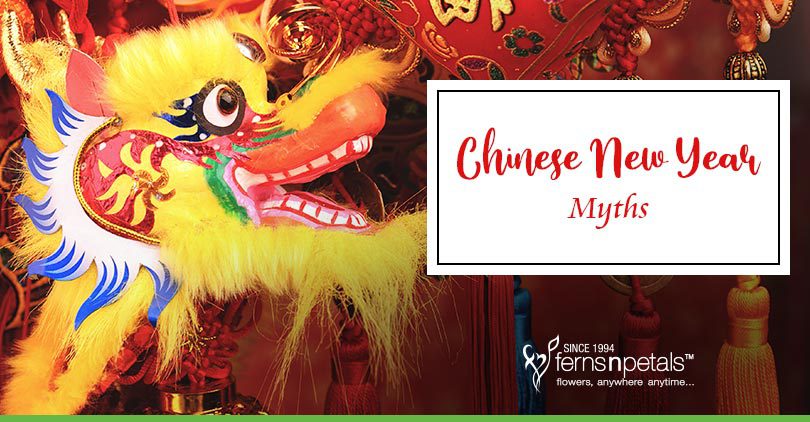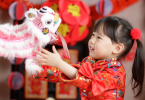Why is red such an important color for the Chinese New Year? What is the significance of lanterns at the end of the festival? These are just two questions to some of the Chinese traditions that are being followed even in this modern era. Everyone is familiar with the superstitions, fairy tales, and myths surrounding their traditions but few are aware of their background story.
Let’s enlighten with information based on some of the famous and most interesting Chinese New Year myths.
Fortune’s Arrival
Amongst the Chinese, the word fú (福) means happiness or fortune. Most houses have this word painted on red paper and pasted upside down.
The reason behind this is that once, the Emperor of the Ming dynasty ordered everyone to decorate their household by pasting fú on their doors. On New Year’s, his soldiers went on around to check, when they found that an illiterate family had hung the word upside down. Angry at their act, the Emperor sentenced the family to death. Luckily, the Empress stepped in and explained that ‘upside down’ (dào) is a homophone of ‘here’, meaning fú is here.
Thus, began the tradition of hanging fú upside down to welcome fortune and in remembrance of the kind-hearted Empress.
Festive Wine for Health
Amongst the few drinks specific to the Chinese New Year, the most loved one is the Tusu Wine. The story goes as a severe plague claimed numerous lives in the village. A man who decided to take things into his own hands concocted a mixture of herbs, grains, and leaves. He distributed it to his neighbors telling them to soak the mix in a bag of water and drink it on New Year’s Day. The villagers felt that this magical drink saved their lives from the plague.
The drink was named Tusu wine, based on that man’s Tusu-structured house. Whether this story is true or not,
wine hampers are always a welcome gift in festivals as joyous as the Chinese New Year.
Scare Away the Monster
In ancient times, it was believed that a monster named Nián lived at the bottom of the sea. This monster would come up to the mainland once a year to feast on humans and animals. Fearing the Nián, villagers would escape into the mountains.
One year, a beggar halted at a village seeking shelter but to his surprise, everyone was running away. Then, an old woman took him in. In return for her kindness, he promised to chase the monster away. At midnight, as Nián trudged, stopped at the sight of red paper on the household doors. The monster roared in anger when suddenly firecrackers burst into the air and it quivered in fear. To make matters worse, the beggar stepped forth dressed in red and laughed at the monster.
The next day, when the villagers returned they were shocked to see no destruction. Then they realized that the color red and loud noises were the monster's Achilles heel.
Since then, red has become the color of the Chinese New Year.
12 Zodiac Animals
The Chinese Zodiac is based on 12 animals, each signifies different things for humans and the year. But how did the animals come to be a part of the zodiac?
One fine day, the Jade Emperor decided that the order in which the animals arrived at his party would be the final order of the Zodiacs. The rat’s cunningness helped him to be the first zodiac animal.
The Rat and Cat had planned on going together but the rat slipped something in the Cat’s drink the night before causing him to oversleep. On the way, Rat found Ox and made a deal with him.
The Ox would carry Rat on his back while Rat would sing motivating songs, but just before they could cross over to the finish line, Rat jumped out in front. Thus, he became the first animal.
With Ox at second place, Tiger and Rabbit secured third and fourth place consecutively. The dragon reached late because he saved a village from drowning. The snake arrived at the same time but was not visible at first. The Horse and Goat travelled together, however, Horse made it before due to his speed. Monkey, Rooster, and Dog came together after assisting a god in a different country. The Pig was the last because he rebuilt his home after a wolf destroyed it.
Lantern Festival
The lantern festival takes place at the end of the fifteen days long celebration. People light up lanterns and release them into the sky. The reason behind this festival lies in an interesting story.
One day, a magnificent swan visited the human world but was shortly killed by a hunter. Upon hearing this news the Jade Emperor was furious and decided to avenge its death. He planned to send his knights to torch Earth. The lower gods were shocked to hear of this plan, so they secretly warned the humans about it. On that night, the humans hung brightly lit lanterns and burst firecrackers to deceive the Emperor into thinking the Earth was on fire.
Hence, humanity was saved from the Jade Emperor’s wrath.
The Chinese culture has a vast number of myths followed in the 21st century. While some of them are as simple as exchanging
Chinese New Year hampers and
good luck wishes.
Here are some more
amazing facts about the Chinese New Year you must read.





